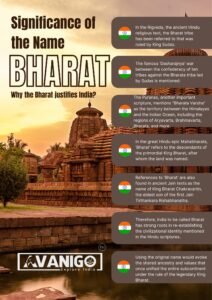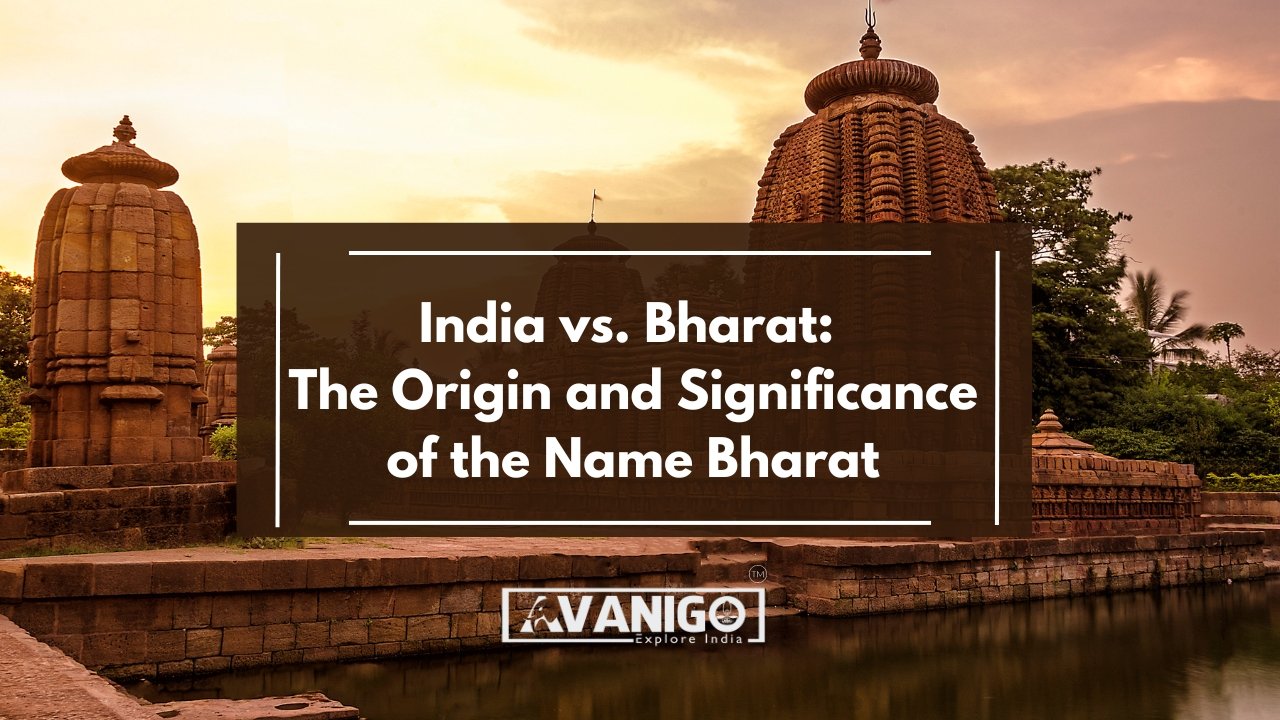India, a country known for its cultures and traditions has been mentioned by names, in historical texts and modern literature. Although ‘India’ and ‘Bharat’ are the two renowned names of India, for the country, their origins and meanings are deeply intertwined with its ancient heritage. As recent speculations around renaming India vs. Bharat have sparked debate, it becomes essential to understand what India vs. Bharat represents and where they emerged from.
Quick Navigation
Why is India called Bharat?
India to be called Bharat finds its earliest mentions in the ancient Hindu scriptures, denoting a geographical region south of the Himalayas. Etymologically, it derives from the Sanskrit word ‘bhrātr̥,’ meaning brother.
According to legends, the land was named ‘Bharatvarsha’ or the ‘Subcontinent of Bharat’ after the legendary emperor Bharat, the son of King Dushyant and Queen Shakuntala. Bharat is credited for uniting the territories of ‘Bharatvarsha’ under one rule, signifying the spirit of brotherhood and unity.
Therefore, the name ‘Bharat’ carries deep-rooted significance, representing the cultural and political unity of the nation. It also denotes the shared ancestry of the inhabitants as descendants of the mythical King Bharat.
The Significance of ‘Bharat’ in Hindu Scriptures
The name ‘Bharat’ holds special importance in Hinduism as it has been mentioned in its prominent scriptures:
- In the Rigveda, the ancient Hindu religious text, one of the sacred texts that gave birth to the Indian philosophy, the Bharat tribe has been referred to that was ruled by King Sudas. The famous ‘Dasharajnya’ war between the confederacy of ten tribes against the Bharata tribe led by Sudas is mentioned. This establishes the roots of the name, dating back to Rigvedic times.
- The Puranas, another important scripture, mentions “Bharata Varsha” as the territory between the Himalayas and the Indian Ocean, including the regions of Aryavarta, Brahmavarta, Bharata, and more.
- In the great Hindu epic Mahabharata, ‘Bharat’ refers to the descendants of the primordial King Bharat, after whom the land was named. The war depicted was between the Kauravas and Pandavas, the warring descendants of the Kuru dynasty to which King Bharat belonged.
- References to ‘Bharat’ are also found in ancient Jain texts as the name of King Bharat Chakravartin, the eldest son of the first Jain Tirthankara Rishabhanatha.
Therefore, India to be called Bharat has strong roots in re-establishing the civilizational identity mentioned in the Hindu scriptures. Using the original name would evoke the shared ancestry and values that once unified the entire subcontinent under the rule of the legendary King Bharat.
The Pre-British Historical Usage of The Term ‘Bharat’
The name ‘Bharat’ has been consistently used in India’s historical documents and literature before the British rule. References to Bharatvarsha or Jambudweep, the ancient names for India, exist in texts like Vedic scriptures, Puranas, and the epics.
For instance, the Rigveda uses the term ‘Bharata’ to refer to a powerful ancient tribe. The writings of ancient travelers like Xuanzang and Al Biruni also refer to the subcontinent as ‘Bharatvarsa.’
Later Indian dynastic empires like the Gupta Empire, Delhi Sultanate, and Mughal Empire referred to their territories as ‘Bharat.’ Even during the medieval era, Indian scholars like Abul Fazl, Alberuni, and Abraham Ecchelena used Bharat in their works on India.
Thus, ‘Bharat’ was organically ingrained in the Indic cultural identity centuries before British influence.
The Origin of the Name ‘India’
The English name ‘India’ derives from the Greek ‘Indos’ and Persian ‘Hind’ denoting the lands around and beyond the Indus River. The Old Persian word ‘Hindush’ referred specifically to the Indus River drainage basin area. This later morphed into ‘India’ under Greek influence after Alexander’s expedition to the subcontinent.
When the British came to India, they adopted the name ‘India’ influenced by Persian usage. Some prominent theories behind this name include:
- The name ‘Hind’ was used by Persians to refer to the lands east of the Indus River, which were beyond their empire. The term meant ‘land of the Hindus’.
- It originated from the Sanskrit word ‘Sindhu,’ meaning ocean and referring to the Indus River. As Greek does not have a ‘sa’ syllable, ‘Sindhu’ became ‘Hindu’ and later ‘India’ in English.
- The ancient Greeks referred to the Indians as ‘Indoi,’ meaning dark-colored. Thus, the land became ‘India.’
Though theories differ, India’s British name certainly originated as a geographical marker used by outsiders. Upon independence in 1947, the leaders retained it instead of reverting completely to the civilizational name ‘Bharat.’ Both names of India were included in the Constitution under Article 1.
‘Bharat’ in India’s Freedom Movement and Constitutional Debates
Bal Gangadhar Tilak was one of the first Indian freedom fighters to emphasize the innate power of invoking why is India called Bharat to mobilize cultural nationalism against British imperialism.
In his book ‘The Arctic Home in the Vedas,’ published in 1903, Tilak analyzed ancient Vedic texts to trace references to ‘Bharat.’ He argued that why is India called Bharat and a unified civilization spread across the subcontinent existed since ancient times under the name Bharata or Bharatvarsha.
Tilak believed reviving this glory and tradition of ‘Bharat’ could stir nationalist sentiments among common Indians to participate in the independence movement. He saw cultural symbolism as a far stronger tool than political strategies, which remained limited to elite intelligentsia.
Tilak organized large community ceremonies and celebrations on Ganesh Chaturthi and Shivaji Jayanti that mixed religious faith with patriotism. References to Bharatbhoomi and ancient indigenous pride became a defining feature of his cultural mobilization drives.
In the Constituent Assembly debates on names of India, contrasting views emerged between retentionists arguing for India vs Bharat. While Ambedkar supported ‘India’ for its global credibility, Munshi argued the geographic descriptor ignored India’s inherent civilization. Rajagopalachari favored ‘Bharat’ more reflective of the country’s ethos and history.
Nehru saw the context in which both names could coexist – ‘Bharat’ for emotions and ‘India’ for international treaties.
Ultimately, to satisfy all sides, Article 1 mentioned why is India called Bharat, ‘ showing intent to assimilate into the national identity. ‘Bharat’ was kept as the official Hindi name while not disbanding ‘India’ to avoid practical hurdles.
The decision balanced cultural assertion with pragmatic needs, much like the independence movement’s dual goals of self-rule and development. It honors the maturation of Indian nationalism envisioned by leaders across ideological divisions.
Why a Name Change from India to Bharat is Significant?
While India remains the official English name used internationally, Bharat represents the indigenous civilizational ethos more accurately.
The motivation behind emphasizing India to be called Bharat is deeper than the political agenda, as some opposition claims. Here’s why this change is significant:
- It evokes cultural pride by removing the colonial imprint of the name India, which originated from foreign sources. Bharat is the Sanskrit indigenous name mentioned in the scriptures.
- It reinstates the cultural identity and values of ‘Bharata’ that signify the population’s unity, brotherhood, and common ancestry under the ancient Emperor Bharat.
- Using Bharat would lead to decolonization from the British legacy, relive Indian philosophy, and establish cultural continuity with the civilization’s grand past.
- It asserts civilizational nationalism as opposed to political nationalism. ‘Bharat’ symbolizes the shared heritage cutting across political divides.
- The transition towards the original Sanskrit name has already begun in government usage in Hindi and other regional languages. Making it official would be formalizing an ongoing process.
Even the Indian national anthem Jana Gana Mana recognizes India as Bharat. Therefore, India to be called Bharat is significant in emancipating India’s identity from European colonial influence and reconnecting with its authentic civilizational ethos. It is a move towards celebrating Indian independence, cultural decolonization and establishing pride in the nation’s unifying heritage.
However, India would remain the official English name used globally for diplomatic and economic purposes. Both names of India represent the ancient and modern facets of the country’s rich history and identity.
Social, Cultural, and Linguistic Significance of ‘Bharat’
‘Bharat’ holds immense social and cultural relevance in representations of Indian identity that transcend political boundaries.
Philosophically, the concept stemmed from the ancient belief that all inhabitants of Bharatvarsha shared a common ancestry from the mythological emperor Bharat. This established cultural connectivity between communities through shared civilizational ethos.
Culturally, the invocation of ‘Bharat’ brings to mind many unifying themes that pervade Indian arts, literature, and folklore. Epics like Ramayana instantiate the geographical idea of Bharatvarsha through references to pilgrimage sites, flora, and fauna found across the subcontinent.
Festivals like Makar Sankranti tell the mythology of King Bharat to millions annually. Heroes like Chhatrapati Shivaji are recalled for their role in defending Bharat Bhushan. Lullabies and folk arts portray ‘Bharatmata’ as a maternal cultural entity.
Linguistically, ‘Bharat’ emerged organically in regional dialects like Bharathi (Tamil), Bhare (Maharashtra), and Bhartiya (Odia), while ‘India’ remained limited to English. This cultural resonance of the word was absent for ‘India,’ which became an imposed political signifier post-colonization. Even today, ‘Bharat’ features strongly in Indian language dailies, literature, and music, representing a homegrown civilizational root distinct from foreign terminologies.
Through such diverse sociocultural associations, ‘Bharat’ captured Indian society’s ethical spirit, collective memories, and shared destiny beyond any single religious or regional identity. No other native term surpassed its power to evoke a Pan-Indian cultural subscription.
This organic cultural predominance of ‘Bharat’ within communities of the subcontinent gives it an indigenous validity lacking in the colonial imprint ‘India.’

Global Examples of Renaming for Decolonization
Many former colonies changed official names post-independence to assert independent identity and decolonization.
- For instance, ‘Burma’ became ‘Myanmar,’ ‘Ceylon’ ‘Sri Lanka,’ ‘Rhodesia’ ‘Zimbabwe,’ ‘Gold Coast’ ‘Ghana’ and ‘South West Africa’ to ‘Namibia.’
Renames were significant in departing from colonial legacies- be it geographic descriptors or rulers’ names. Similarly, ‘Bharat’ detached India’s identity from its English descriptor derived during the colonial era.
The name change symbolizes ownership over history, moving beyond political control to a self-determined authentic self-image. It gives precedents that India to be called Bharat, too, can reclaim its pre-colonial designation as a cultural statement of autonomy similar to other post-colonies.
The resurgence of ‘Bharat’ as a Geographic-Cultural Idea
The indigenous name ‘Bharat’ undoubtedly carries immense historical and civilizational significance compared to the externally derived name ‘India.’
However, while a formal name change is being considered, it should not be interpreted simply as BJP’s political agenda but as a much-needed cultural transition.
Moving towards the civilizational name ‘Bharat’ is a discreet way for India to decolonize and assert its authentic identity that triumphs over narrow political divides.
Though nothing would change for India vs Bharat purposes globally, reclaiming ‘Bharat’ as the sole official name within the country is a prospect that deserves fair deliberation without blind opposition.
About the Author:
Swetha Prasanna Gangavarapu is a Content Strategist, Personal Branding Consultant, and Senior Freelance Content Writer adept at Content Strategy and Marketing. Indian Culture and Traditions deeply enthuse her. When not playing with words, she loves exploring the world by traveling. She is the author of the LinkedIn Personal Branding Book: 365 Days 365 Posts. She is reachable on LinkedIn or her website www.swethaprasanna.com for Consultation.

